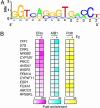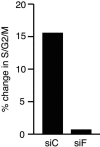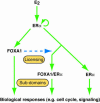From the Cover: Location analysis of estrogen receptor alpha target promoters reveals that FOXA1 defines a domain of the estrogen response
- PMID: 16087863
- PMCID: PMC1183449
- DOI: 10.1073/pnas.0505575102
From the Cover: Location analysis of estrogen receptor alpha target promoters reveals that FOXA1 defines a domain of the estrogen response
Abstract
Nuclear receptors can activate diverse biological pathways within a target cell in response to their cognate ligands, but how this compartmentalization is achieved at the level of gene regulation is poorly understood. We used a genome-wide analysis of promoter occupancy by the estrogen receptor alpha (ERalpha) in MCF-7 cells to investigate the molecular mechanisms underlying the action of 17beta-estradiol (E2) in controlling the growth of breast cancer cells. We identified 153 promoters bound by ERalpha in the presence of E2. Motif-finding algorithms demonstrated that the estrogen response element (ERE) is the most common motif present in these promoters whereas conventional chromatin immunoprecipitation assays showed E2-modulated recruitment of coactivator AIB1 and RNA polymerase II at these loci. The promoters were linked to known ERalpha targets but also to many genes not directly associated with the estrogenic response, including the transcriptional factor FOXA1, whose expression correlates with the presence of ERalpha in breast tumors. We found that ablation of FOXA1 expression in MCF-7 cells suppressed ERalpha binding to the prototypic TFF1 promoter (which contains a FOXA1 binding site), hindered the induction of TFF1 expression by E2, and prevented hormone-induced reentry into the cell cycle. Taken together, these results define a paradigm for estrogen action in breast cancer cells and suggest that regulation of gene expression by nuclear receptors can be compartmentalized into unique transcriptional domains by means of licensing of their activity to cofactors such as FOXA1.
Figures





References
-
- Osborne, C. K. & Schiff, R. (2005) J. Clin. Oncol. 23, 1616–1622. - PubMed
-
- Smith, C. L. & O'Malley, B. W. (2004) Endocr. Rev. 25, 45–71. - PubMed
-
- O'Lone, R., Frith, M. C., Karlsson, E. K. & Hansen, U. (2004) Mol. Endocrinol. 18, 1859–1875. - PubMed
-
- Herrlich, P. (2001) Oncogene 20, 2465–2475. - PubMed
-
- Pfahl, M. (1993) Endocr. Rev. 14, 651–658. - PubMed
Publication types
MeSH terms
Substances
LinkOut - more resources
Full Text Sources
Other Literature Sources
Molecular Biology Databases
Miscellaneous

